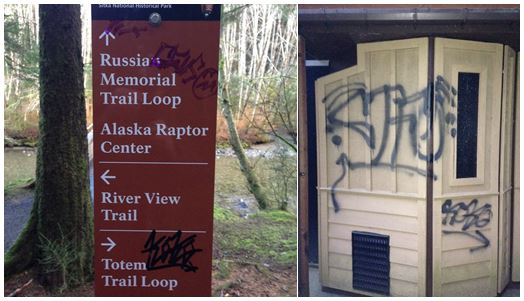
The graffiti cleans easily off the new directional signs (left), but wooden surfaces will have to wait for warmer, dryer weather before they can be repainted. (SNHP photos)
Sitka National Historical Park has been subject to an unprecedented level of vandalism recently.
Within the past week, nearly every flat surface in the downtown Sitka park has been marked with one or more graffiti tags.
Under different circumstances, graffiti tags are an accepted urban art form. If you’ve ever taken the light rail downtown from SeaTac Airport in Seattle, you may have been impressed by the graffiti.
Well, officials in Sitka National Historical Park are not impressed. Nearly all of the park’s brand new directional and wayside interpretive signs have been tagged.
Act: in SNHP office
Park maintenance staff have been able to remove the graffiti tags written in felt-tip pen almost as soon as they’re discovered. But vandals have since stepped up their game and begun applying spray paint.
Ranger Becky Latanich is head of interpretation at the park. I stopped by her office and we sat down at her computer to look at pictures of what’s been going on.
Latanich – Both the directional signs and the waysides are new as of last year, and represent three-and-a-half years of solid effort, and now they’re being defaced. So that’s one of the frustrating things. And then there are things like this, which have to be sanded and repainted.
KCAW – That’s a metal trash can?
Latanich – That’s a metal trash can. So 25 different tags have been in the park. Some are very small, just a couple of inches, and some are several feet across. And the park, in the five-and-a-half years since I’ve been here has not seen this level of vandalism. We’ve seen the occasional tags, or etching on the bridge, that kind of thing. But nothing to this extent, and certainly not concentrated within this short amount of time.
New tags have been appearing almost every night. Park personnel would like to put an end to it, and they’re using social media and other tools to involve the community in what — for the moment — is a relatively isolated problem.
Latanich – Part of it is developing community awareness around this. So we’re going to post the photos on Facebook. The nature of tags is that they are a sort of signature. The same two repeat themselves: ‘KOKO’ and ‘VV,’ and they repeat themselves frequently. So if they start showing up in other places, it’s easy to start to see patterns. As far as I know the park is working with the Sitka Police Department, and there’s a graffiti database, where they try and match up perpetrators with various locations, so that’s good. Part of it is about community policing. There are many more people who walk in the park, obviously, than there are park staff, so part of it is about generating community awareness so that if somebody sees something like this in action or if they suspect who might be associated with it, that they contact us. The goal is, the community doesn’t want a park that’s been defaced. We put lots of money and effort into these resources. It’s one of our signature places for our visitors in the summer season. We want them to have a great experience. The community depends on maintaining a nice-looking park for many reasons.
Latanich says it will take dryer weather before some of the wooden and metal surfaces can be sanded and repainted. She has no theories about why the park has been targeted. It is a travel corridor between downtown and Sawmill Creek Road neighborhoods, and other places along the corridor — the sea walk, for example — have also been tagged with graffiti.
Sitka National Historical Park is considered an urban park, and other urban parks have adopted strategies to channel graffiti in a more positive direction, like a dedicated graffiti wall. Latanich says they haven’t ruled out that possibility in the future, if graffiti continues to be a problem.
But right now, she says, it’s only been a week, “and we really want to catch the perpetrators.”































